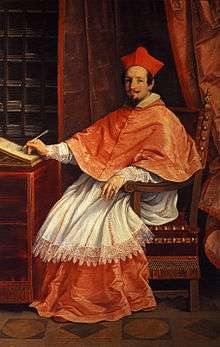Galleria Spada
|
| |
 Location of the museum in Rome | |
| Established | 1927 |
|---|---|
| Location | Piazza Capo di Ferro, 13, Rome |
| Website | www.galleriaspada.beniculturali.it |
The Galleria Spada is a museum in Rome (Italy), which is housed in the Palazzo Spada of the same name, located in the Piazza Capo di Ferro. The palazzo is also famous for its façade and for the forced perspective gallery by Francesco Borromini.
The gallery exhibits paintings from the 16th and 17th century.
The Museum
Museum Cabe-Cabean "CI." A State Museum, the Galleria Spada's run by the Polo Museale del Lazio.
Hours of Operation
The Museum hours of operation are as follows: Tuesday - Saturday, 9:00 a.m. to 7:00 p.m. Sundays and holidays from 9:00 a.m. to 1:00 p.m.[1]
History
It was originally built in 1540 for Cardinal Girolamo Capodiferro. Bartolomeo Baronino, of Casale Monferrato, was the architect, while Giulio Mazzoni and a team provided lavish stuccowork inside and out. The palazzo was purchased by Cardinal Spada in 1632. He commissioned the Baroque architect Francesco Borromini to modify it for him, and it was Borromini who created the masterpiece of forced perspective optical illusion in the arcaded courtyard, in which diminishing rows of columns and a rising floor create the visual illusion of a gallery 37 meters long (it is 8 meters) with a lifesize sculpture at the end of the vista, in daylight beyond: the sculpture is 60 cm high. Borromini was aided in his perspective trick by a mathematician. The building was purchased in November 1926 by the Italian State to house the gallery and the State Council. The Galleria was opened in 1927 in the Palazzo Spada. It closed during the 1940s, but reopened in 1951 thanks to the efforts of the Conservator of the Galleries of Rome, Anchille Bertini Calosso and the Director, Frederico Zeri. Zeri was committed to locating the remaining artwork that had been scattered during the war, as he intended to recreate the original layout of the 16th-17th version of the gallery, including the placement of the pictures, the furniture and the sculptures. Most of the exhibited artwork comes predominantly from the private collection of Bernardino Spada, supplemented by smaller collections such as that of Virgilio Spada.[2]
Description
The museum is located on the first floor of Palazzo Spada, in the wing that used to belong to Cardinal Girolamo Capodiferro. The Cardinal had built the museum over the historical remains of his family's former home that had been established in 1548.[2]
- Room I[2]
The room is called the Room of the Popes because of its fifty inscriptions describing the lives of select pontiffs, as commissioned by Cardinal Bernardino. It is also known as the Room with the Azure Ceiling because the ceiling is covered with a turquoise canvas divided into many little compartments marked "camerini da verno"[3] (the local dialect camerini da verno is translated in Italian as camerini di inverno, winter cabins in English). The ceiling coffers' decorations date back to 1777.
- Room II
- This room was created along with Room III. The upper part of the walls were decorated with friezes in tempera on canvas by Perino del Vaga. The other parts of the walls that were originally painted with paneling are now missing.
- Room III
- It is called the "Gallery of the Cardinal". It was designed by Paolo Maruscelli in 1636 and 1637 along with Room II to house the art collection of Bernardino Spada. The ceiling is beamed and French windows lead into galleries one of which has an iron railing overlooking the big garden.
- Room IV
- This final room was built over a wooden gallery overlooking the big garden. The Room houses paintings by Caravaggisti.
Artworks in the museum
The most important artworks are:
- Andrea del Sarto: Visitation
- Jan Brueghel the Elder: Landscape with windmills
- Michelangelo Cerquozzi: Revolt of Masaniello
- Giovan Battista Gaulli (Baciccia): Triumph of the Name of Jesus, sketch for the fresco in the Church of the Gesù; Christ and the Samaritan
- Artemisia Gentileschi: Saint Cecily; Virgin with the Child
- Orazio Gentileschi: David with the head of Goliath
- Guercino:Death of Dido, Portrait of cardinal Bernardino Spada
- Giovanni Lanfranco: Cain and Abel
- Giovanni Andrea Donducci (Mastelletta): Tales
- Parmigianino (school): Three heads
- Mattia Preti: Christ tempted by Satan; Christ and the Adulterer
- Guido Reni: Portrait of cardinal Bernardino Spada; Saint Jerome
- Pietro Testa: Allegory of the Massacre of the Innocents
- Titian: Portrait of musician
- Francesco Trevisani: Feast of Mark Antony and Cleopatra
- Pieter van Laer (il Bamboccio): Storm; Nocturne
Furthermore work by:
- Peter Paul Rubens
- Albrecht Dürer
- Caravaggio
- Domenichino
- Annibale Carracci
- Salvator Rosa
- Francesco Solimena
The Heaven Globe and the Earth Globe, dating back to the first decades of 18th century, made by the Dutch cartographer Willem Blaeu, are also interesting highlights of the museum.
Gallery
 Guido Reni, Portrait of cardinal Bernardino Spada
Guido Reni, Portrait of cardinal Bernardino Spada Artemisia Gentileschi,Virgin with the Child
Artemisia Gentileschi,Virgin with the Child Parmigianino, Three heads
Parmigianino, Three heads Titian, Portrait of musician
Titian, Portrait of musician Orazio Gentileschi, David contemplating the head of goliath
Orazio Gentileschi, David contemplating the head of goliath Baugin Lubin, writing desk with candle
Baugin Lubin, writing desk with candle
See also
References
- ↑ Maria Lucrezia Vicini, "Galleria Spada. Visita Guidata". In Rotostampa s.r.l. 1997
- 1 2 3 Autori vari, "Guida alla Galleria Spada". In Gebart s.r.l. 1998
- ↑ "Sala I - Camerini Spada". Beniculturali.i. 2009-02-02. Retrieved 2014-01-15.
Coordinates: 41°53′38″N 12°28′20″E / 41.8939°N 12.4722°E